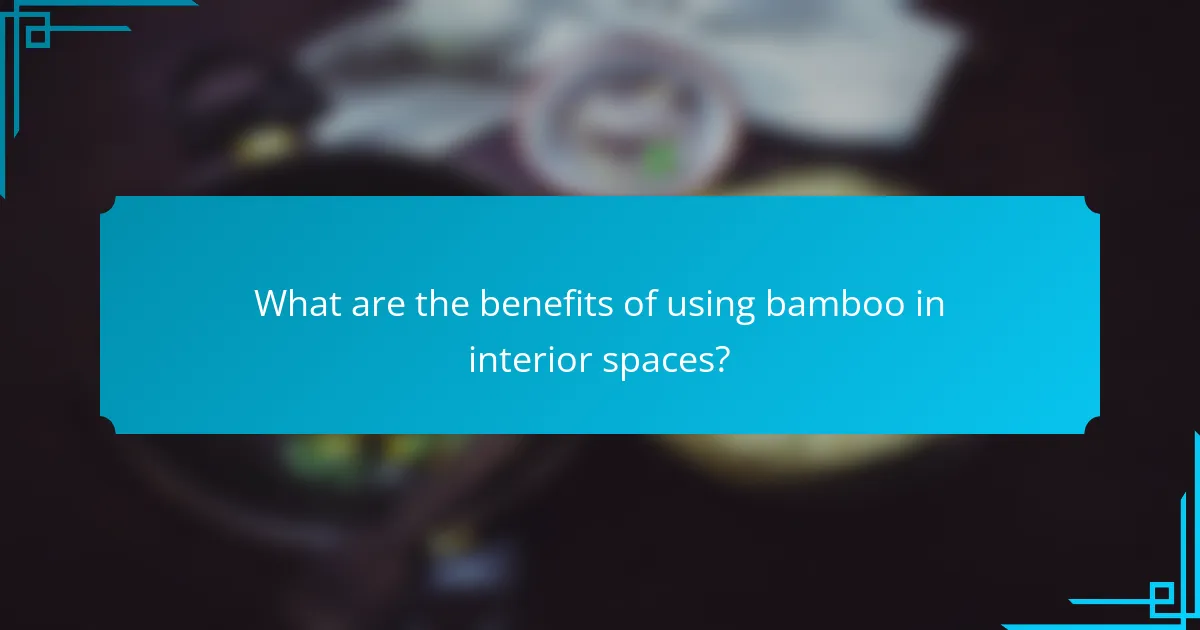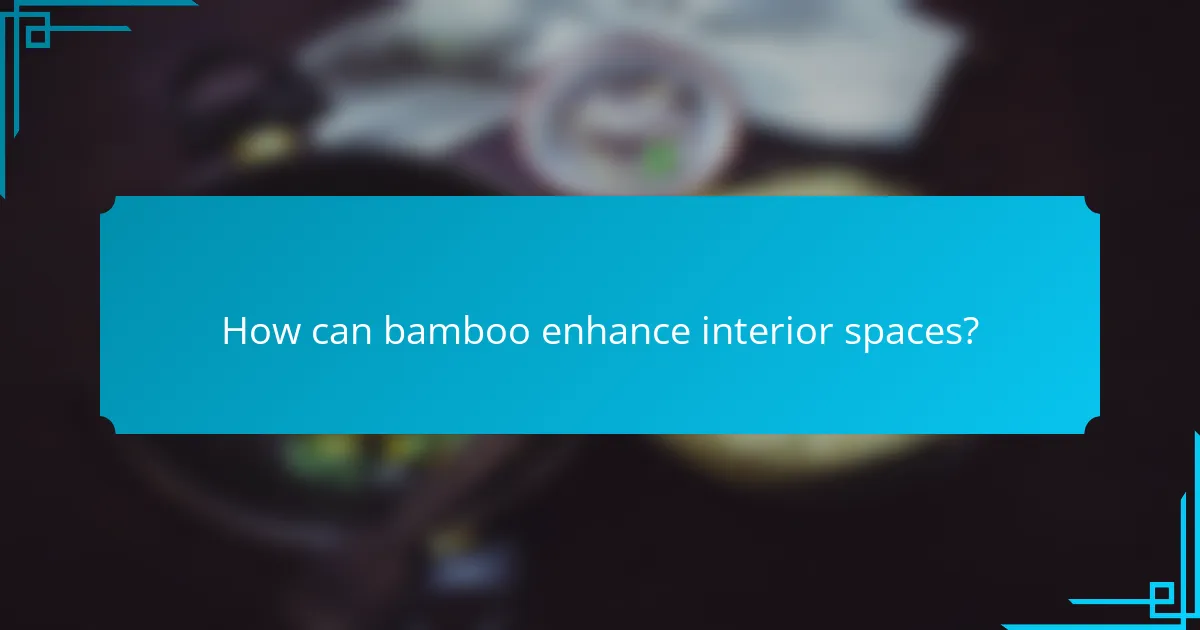Bamboo is a sustainable material that offers numerous advantages for interior spaces, including eco-friendliness, durability, and design versatility. It grows rapidly and can be harvested responsibly, making it an environmentally conscious choice. Bamboo enhances aesthetics with its natural look and unique texture while providing strength comparable to steel, suitable for flooring and furniture. Additionally, it contributes positively to indoor air quality by absorbing toxins. When considering bamboo, factors such as moisture resistance, pest susceptibility, sourcing, and maintenance are important for effective use in various design styles.

What are the benefits of using bamboo in interior spaces?
Bamboo offers numerous benefits when used in interior spaces. It is an eco-friendly material, as it grows rapidly and can be harvested sustainably. Bamboo absorbs carbon dioxide and releases oxygen, contributing positively to air quality. Its natural aesthetic enhances the visual appeal of interiors. Bamboo is also highly durable, with a tensile strength comparable to steel. This durability makes it suitable for flooring, furniture, and decorative elements. Additionally, bamboo is lightweight, which simplifies installation and transport. Its versatility allows for various design styles, from modern to traditional. These attributes make bamboo a popular choice for environmentally conscious consumers.
How does bamboo contribute to eco-friendliness in interior design?
Bamboo contributes to eco-friendliness in interior design through its rapid growth and renewability. It can grow up to 91 cm in a single day, making it one of the fastest-growing plants. This quick growth allows for sustainable harvesting without depleting resources. Bamboo also absorbs more carbon dioxide and releases more oxygen compared to many tree species. This property helps mitigate climate change by reducing greenhouse gases. Additionally, bamboo requires minimal pesticides and fertilizers, leading to lower chemical usage in its cultivation. Its natural durability reduces the need for chemical treatments in processing. Overall, bamboo’s attributes make it an environmentally friendly choice for interior design.
What makes bamboo a sustainable material compared to others?
Bamboo is a sustainable material due to its rapid growth and renewability. It can grow up to three feet in 24 hours and reaches maturity in three to five years. This growth rate is significantly faster than traditional hardwoods, which can take decades to mature. Bamboo also requires minimal water and no pesticides for cultivation. Its extensive root system prevents soil erosion and promotes biodiversity. Additionally, bamboo absorbs more carbon dioxide than many trees, contributing to lower greenhouse gas levels. These attributes make bamboo a highly sustainable choice compared to other materials.
How does bamboo cultivation impact the environment positively?
Bamboo cultivation positively impacts the environment by enhancing carbon sequestration. It absorbs more carbon dioxide than most trees, making it an effective tool against climate change. Bamboo can sequester up to 12 tons of carbon dioxide per hectare annually. Additionally, bamboo helps prevent soil erosion due to its extensive root system. This system stabilizes the soil and reduces runoff. Bamboo also promotes biodiversity by providing habitats for various species. Its rapid growth allows for quicker regeneration compared to traditional timber sources. This sustainable growth reduces deforestation and promotes renewable resource use. Overall, bamboo cultivation contributes significantly to ecological balance and environmental health.
What are the durability characteristics of bamboo as a building material?
Bamboo is a highly durable building material. It exhibits exceptional strength-to-weight ratio, making it suitable for various construction applications. Bamboo can withstand tensile forces better than steel, providing robust structural integrity. Its natural resistance to pests and decay enhances its longevity. Bamboo also has a moisture content that allows it to adapt to environmental changes without significant deformation. Studies show that properly treated bamboo can last for decades in both indoor and outdoor settings. For instance, research indicates that treated bamboo can resist fungal growth and insect damage effectively.
How does bamboo compare to traditional wood in terms of strength?
Bamboo is stronger than many traditional woods. It has a tensile strength of about 28,000 psi. This is higher than that of steel, which averages around 23,000 psi. Bamboo’s compressive strength is also notable, reaching approximately 14,000 psi. In comparison, oak has a compressive strength of about 12,000 psi. Bamboo’s unique structure contributes to its strength. Its fibers are tightly packed, providing excellent load-bearing capabilities. Studies show that bamboo can withstand significant stress without breaking. This makes it a durable option for construction and furniture.
What factors contribute to the longevity of bamboo products?
Bamboo products have a long lifespan due to their natural strength and resilience. The unique structure of bamboo, with its hollow stems, allows it to withstand significant stress. Additionally, bamboo has a high tensile strength, comparable to steel, which contributes to its durability. Proper treatment and processing methods also enhance bamboo’s resistance to pests and moisture. The growth rate of bamboo is rapid, allowing for sustainable harvesting without compromising the ecosystem. Studies show that well-maintained bamboo can last for decades in various applications. These factors collectively ensure that bamboo products remain functional and aesthetically pleasing over time.
In what ways does bamboo offer design versatility for interior spaces?
Bamboo offers design versatility for interior spaces through its aesthetic appeal and adaptability. It comes in various forms, including flooring, furniture, and decorative elements. Bamboo can be stained or finished in different colors to match diverse design themes. Its natural texture adds warmth and character to spaces. Bamboo is lightweight yet strong, making it easy to work with for various applications. It can be used in contemporary, traditional, and eclectic designs. The sustainable nature of bamboo also appeals to eco-conscious consumers. Its rapid growth and renewability make it a responsible choice for interior design.
What styles of interior design can effectively incorporate bamboo?
Bamboo can be effectively incorporated into several styles of interior design. These styles include modern, tropical, and Asian-inspired designs. Modern design often utilizes bamboo for its sleek lines and minimalistic aesthetic. Tropical design embraces bamboo for its natural, organic feel and connection to nature. Asian-inspired design highlights bamboo’s cultural significance and traditional craftsmanship. Each of these styles benefits from bamboo’s eco-friendliness and versatility. Bamboo can be used in furniture, flooring, and decorative elements across these design styles. Its durability also makes it suitable for high-traffic areas in modern and tropical interiors.
How can bamboo be used in various forms (e.g., furniture, flooring)?
Bamboo can be used in various forms, including furniture and flooring. As furniture, bamboo is crafted into chairs, tables, and cabinets. Its lightweight nature makes it easy to move and arrange. Bamboo flooring is popular for its durability and aesthetic appeal. It can withstand heavy foot traffic and resist moisture. Additionally, bamboo is a sustainable resource, growing rapidly and requiring minimal resources. This eco-friendliness enhances its appeal in modern interior design. Bamboo products often feature unique grain patterns, adding to their visual interest. Hence, bamboo serves as a versatile material in both functional and decorative applications.

How can bamboo enhance interior spaces?
Bamboo enhances interior spaces through its aesthetic appeal, sustainability, and versatility. It offers a natural look that complements various design styles. Bamboo is a renewable resource, growing rapidly and requiring minimal resources. This eco-friendliness makes it a popular choice for environmentally conscious consumers. Additionally, bamboo is strong and durable, making it suitable for flooring and furniture. Its unique texture adds warmth and character to interiors. Studies show that bamboo can improve indoor air quality by absorbing toxins. Overall, bamboo contributes to stylish, sustainable, and healthy living environments.
What aesthetic benefits does bamboo provide in interior design?
Bamboo provides several aesthetic benefits in interior design. Its natural grain patterns create a warm and inviting atmosphere. The light color of bamboo enhances brightness in spaces. Bamboo’s versatility allows it to complement various design styles, from modern to traditional. Additionally, its unique texture adds visual interest to interiors. Bamboo can be used in flooring, furniture, and decorative elements. This material is also sustainable, promoting an eco-friendly aesthetic. Overall, bamboo contributes to a harmonious and stylish environment.
How does bamboo influence the overall ambiance of a space?
Bamboo enhances the overall ambiance of a space by adding a natural and calming aesthetic. Its warm tones and organic textures create a soothing environment. Bamboo is known for its versatility in design, making it suitable for various styles. This adaptability allows it to blend seamlessly with other materials. The use of bamboo can improve air quality, as it is a natural air purifier. Research indicates that bamboo absorbs carbon dioxide and releases oxygen more efficiently than many trees. Additionally, bamboo’s sustainable nature contributes to an eco-friendly atmosphere. The presence of bamboo can evoke a sense of tranquility and connection to nature, positively impacting mood and well-being.
What color and texture options are available with bamboo products?
Bamboo products are available in a variety of colors and textures. Common colors include natural, caramel, and dark brown. The natural color showcases the original hue of bamboo. Caramel is achieved through a heating process that enhances the wood’s appearance. Dark brown is often created by staining the bamboo.
Texture options vary from smooth to textured finishes. Smooth bamboo provides a sleek and modern look. Textured finishes can include bamboo woven patterns or distressed appearances. These variations allow for diverse design applications in interior spaces. The versatility in color and texture makes bamboo suitable for various aesthetic preferences.
How does the use of bamboo align with modern design trends?
The use of bamboo aligns with modern design trends through its sustainable attributes and aesthetic versatility. Bamboo is a rapidly renewable resource, making it an eco-friendly choice for contemporary design. Its natural texture and warm tones complement various design styles, from minimalist to rustic. Additionally, bamboo’s strength and durability enhance its appeal for furniture and flooring. Studies show that incorporating sustainable materials like bamboo can increase the perceived value of interior spaces. Designers often favor bamboo for its ability to create a harmonious connection with nature, aligning with the biophilic design trend. This trend emphasizes the importance of natural elements in creating healthy living environments.
What are the current trends in sustainable interior design featuring bamboo?
Current trends in sustainable interior design featuring bamboo include the use of bamboo for flooring, furniture, and decorative elements. Bamboo is favored for its rapid growth and renewability, making it an eco-friendly choice. Designers are increasingly incorporating bamboo in minimalist and biophilic designs. The material’s natural aesthetic enhances indoor environments while promoting sustainability. Additionally, bamboo’s strength and durability make it suitable for various applications. Recent studies show that bamboo can sequester carbon effectively, further supporting its use in eco-conscious design. The versatility of bamboo allows for innovative applications in both residential and commercial spaces.
How can bamboo be integrated into minimalist design concepts?
Bamboo can be integrated into minimalist design concepts through its clean lines and natural aesthetics. Its lightweight and strong properties make it suitable for furniture and structural elements. Designers often use bamboo for flooring, cabinetry, and decorative accents. The neutral tones of bamboo complement minimalist color palettes effectively. Bamboo’s sustainability aligns with the eco-friendly principles of minimalist design. Additionally, its versatility allows for various forms, from sleek furniture to intricate wall designs. Research shows that incorporating natural materials like bamboo enhances indoor air quality, contributing to a healthier living environment.

What practical considerations should be taken into account when using bamboo?
When using bamboo, consider its moisture resistance and susceptibility to pests. Bamboo is naturally resistant to moisture, making it suitable for humid environments. However, untreated bamboo can attract pests like termites. It is essential to apply proper treatments to enhance durability. Additionally, consider the source and sustainability of the bamboo. Harvesting methods impact environmental sustainability. Ensure that the bamboo is sourced from responsible suppliers. Lastly, take into account the maintenance requirements. Bamboo surfaces need regular cleaning and occasional refinishing to maintain their appearance. These considerations ensure effective and sustainable use of bamboo in interior spaces.
What maintenance practices are recommended for bamboo products?
Bamboo products require specific maintenance practices to ensure longevity. Regular cleaning with a damp cloth helps remove dust and debris. Avoid using harsh chemicals or abrasive materials, as they can damage the surface. Applying a natural wood conditioner periodically can enhance the product’s appearance and protect against wear. Keeping bamboo products away from direct sunlight prevents fading and warping. Maintaining humidity levels in the environment can also prevent cracking. Regular inspections for signs of damage allow for timely repairs. Following these practices can significantly extend the life of bamboo products.
How can one ensure the longevity of bamboo in high-traffic areas?
To ensure the longevity of bamboo in high-traffic areas, apply a protective finish. A high-quality sealant protects against moisture and wear. Regular maintenance, such as cleaning and reapplying the finish, extends its lifespan. Use rugs or mats in particularly busy sections to reduce direct wear. Choose strand-woven bamboo for increased durability; it is denser and more resistant to damage. Proper installation, including acclimation to the environment, minimizes warping and cracking. Bamboo should be installed over a stable subfloor to prevent movement. Following these practices significantly enhances bamboo’s durability in high-traffic environments.
What are the best practices for sourcing bamboo sustainably?
The best practices for sourcing bamboo sustainably include choosing bamboo from certified sustainable sources. Look for certifications such as FSC (Forest Stewardship Council) or PEFC (Programme for the Endorsement of Forest Certification). These certifications ensure responsible forest management and environmental protection. It is also important to source bamboo that is grown in its native habitat. Bamboo thrives best in its natural environment, which minimizes the need for chemical fertilizers and pesticides. Additionally, consider the harvesting methods used. Sustainable harvesting practices involve cutting bamboo without destroying the plant’s root system, allowing it to regenerate quickly. Lastly, support local bamboo producers to reduce transportation emissions and promote community economies. Following these practices contributes to environmental sustainability and supports ethical sourcing.
How can consumers identify high-quality bamboo products?
Consumers can identify high-quality bamboo products by examining several key factors. Look for products made from Moso bamboo, known for its strength and durability. Check for certifications like FSC (Forest Stewardship Council) to ensure sustainable sourcing. Inspect the finish; high-quality bamboo should have a smooth, even surface without splinters. Evaluate the density; denser bamboo indicates better quality and durability. Review the manufacturer’s reputation and customer reviews for reliability. Lastly, consider the price; extremely low-cost bamboo products may compromise quality. These indicators help consumers make informed choices about bamboo products.
What tips can help in effectively incorporating bamboo into interior spaces?
Use bamboo as flooring for its durability and eco-friendliness. Bamboo flooring is harder than oak, offering resilience. Incorporate bamboo furniture for a natural aesthetic. Bamboo furniture is lightweight yet sturdy. Use bamboo wall panels to create a warm atmosphere. These panels can enhance insulation and reduce noise. Add bamboo accents in decor, such as vases or artwork. These elements provide a cohesive theme. Consider bamboo window treatments for style and functionality. Bamboo shades are known for their versatility and light control.
The main entity of this article is bamboo, highlighting its benefits in interior spaces. Bamboo is recognized for its eco-friendliness, rapid growth, and sustainable harvesting, making it a strong choice for environmentally conscious design. The article discusses bamboo’s durability, showcasing its strength comparable to steel, and its versatility across various design styles. It also emphasizes bamboo’s aesthetic appeal, contributing to improved indoor air quality and a natural ambiance. Practical considerations for maintenance and sourcing high-quality bamboo products are addressed to ensure effective use in interior design.